Years ago, the Intel Xeon D-1500 series was a new product line for Intel. The Supermicro X10SDV series of Xeon D-1500 series reviews were very popular. Now, we have the Ice Lake-D version, the Supermicro X12SDV-4C-SP6F. This has a lower-end Intel Xeon D-1718T but that is only part of the story. Supermicro is also utilizing the chip’s onboard 25GbE networking.
Supermicro X12SDV-4C-SP6F Overview
The motherboard itself is one of Supermicro’s FlexATX offerings. While Supermicro still has many mITX offerings, the additional capabilities of today’s Intel Xeon D and Atom offerings often mean that there is more I/O than can be reasonably fit onto a mITX platform. As a result, Supermicro has a line of FlexATX motherboards that use the extra width to expose that I/O.
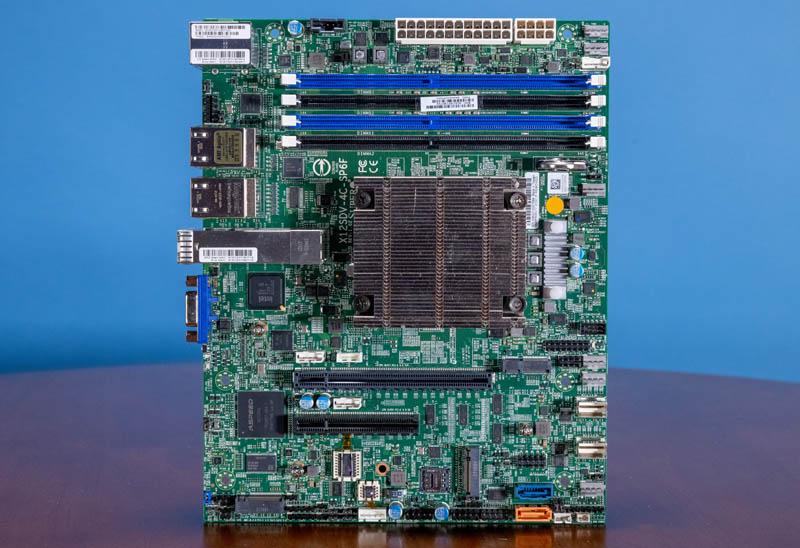
The X12SDV tells us it is a X12 single socket Xeon D platform. The -4C- in the model number tells us this is a 4-core Xeon D. In this case, it is the Intel Xeon D-1718T. One may immediately think of it as the update to the Intel Xeon D-1518. Embedded parts have a 7+ year lifecycle, so 2015 to 2022 would be about right. If you want to learn more about the Xeon D-1700 and D-2700 series, check out our video:
The part still is 4 cores/ 8 threads, but it is a two or two and a half generation newer microarchitecture with more cache. Base clock speeds are up almost 20% and there is the ability to boost to almost 60% higher clocks than that predecessor. That is a decent tradeoff for a 11W TDP bump, but we also get faster memory, PCIe Gen4 (the older generation was Gen2 and Gen3), and a host of other new features.
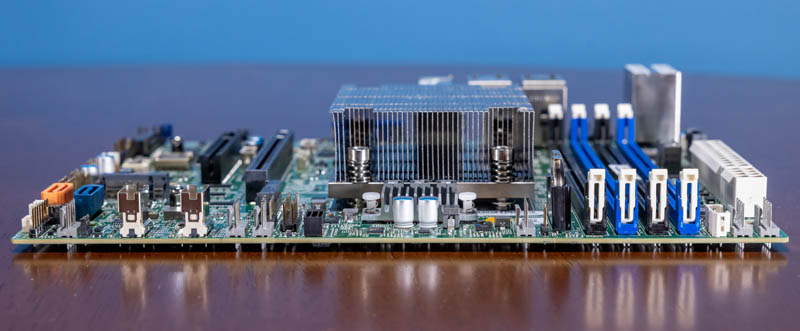
We wanted to quickly point out that many of our readers will see a passive heatsink affixed to this motherboard. That is because it is designed for chassis fans providing airflow. The small heatsink is not enough to keep the 46W SoC cool without chassis airflow.
Supermicro is using a more traditional two-channel and two DIMM per channel (2DPC) layout here. As we covered in our Welcome to the Intel Ice Lake D Era piece, the Xeon D-1700 actually has three memory channels available, but we commonly see two channels being placed as they are here. On top of the memory channels is a sticker with the BMC password.
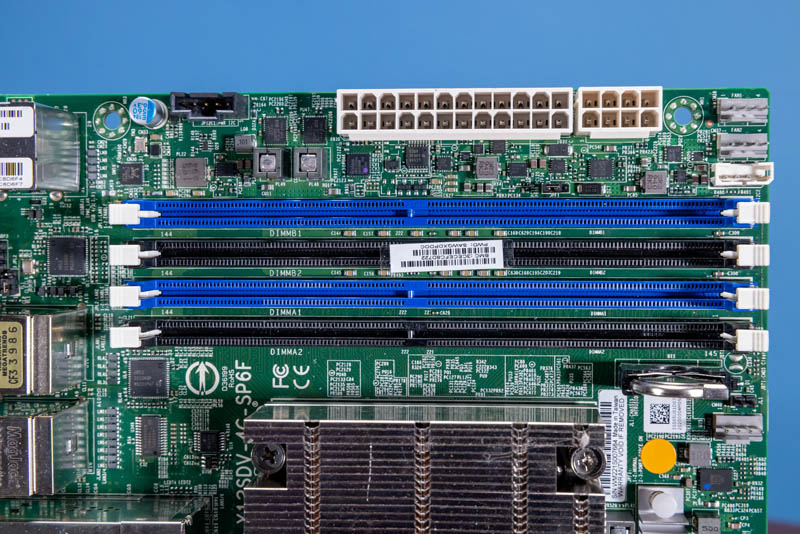
On the bottom of the motherboard, we get the Intel i350 NIC, the BMC, two PCIe slots, and other storage connectivity.
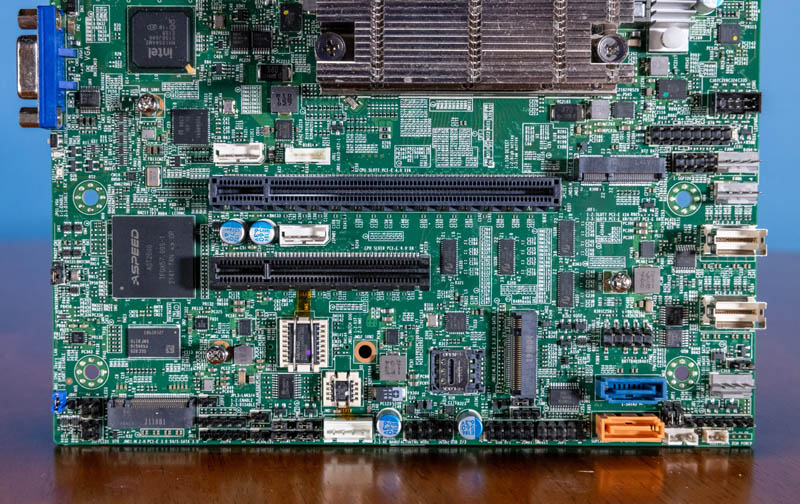
The two PCIe slots can be configured as PCIe Gen4 x16 or the second slot can be used in a Gen4 x8/x8 configuration.
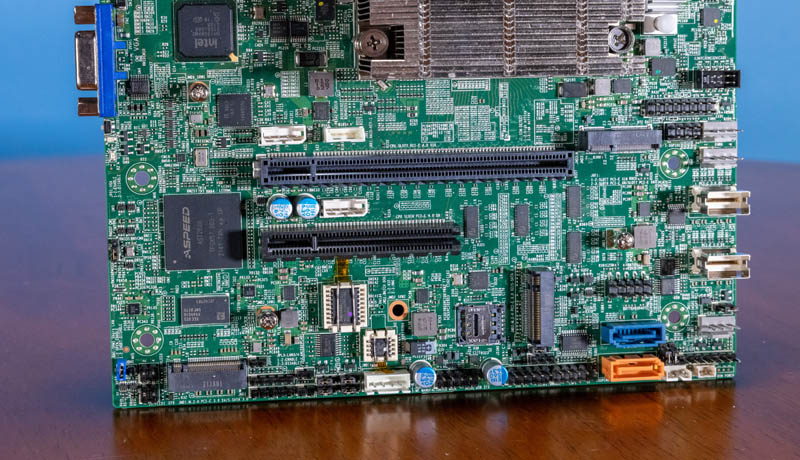
One feature we appreciate is that Supermicro uses an open-ended x8 physical slot to allow for longer cards to be placed in the slot.
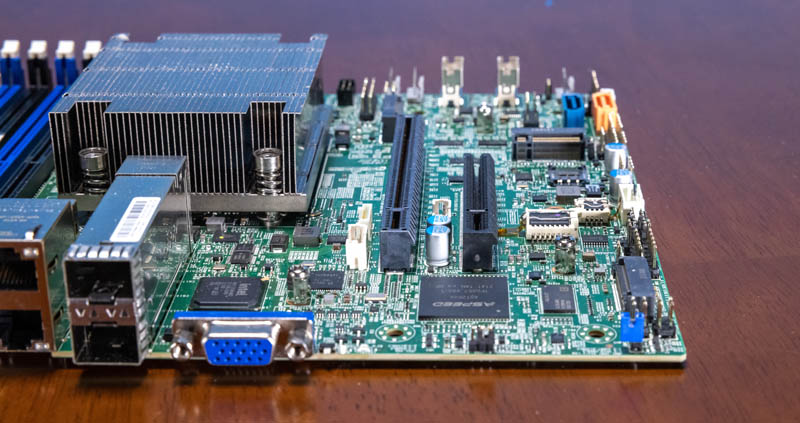
On the M.2 slot, there is a SATA / PCIe Gen3 x4 slot. There is also a Gen3 x2 slot that supports SATA/ PCIe/ USB 3. There is also a PCIe Gen3 x1 slot.
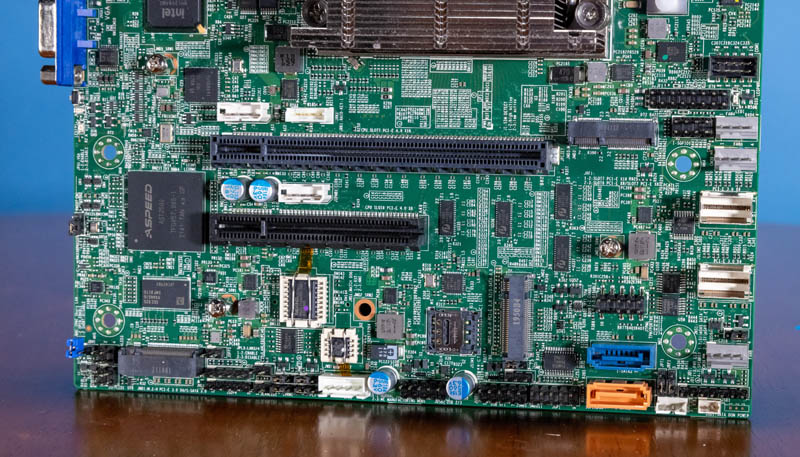
In this generation, we only get two 7-pin SATA headers. The “gold” header provides SATADOM power. There are also two SlimSAS connectors that can provide either PCIe Gen3 x4 lanes via cabling or 4x SATA III ports.
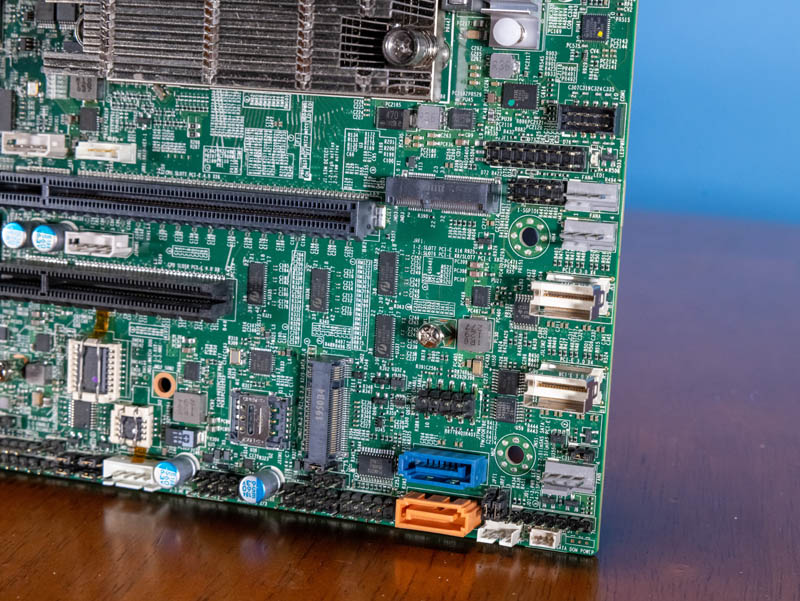
Perhaps the most exciting feature is the rear I/O. Here we get Supermicro’s standard two USB 3 Type-A ports, a VGA port, and an out-of-band management port. Then comes the networking. There are four 1GbE ports. Two are Intel i210 and an Intel i350-am2 powers two.
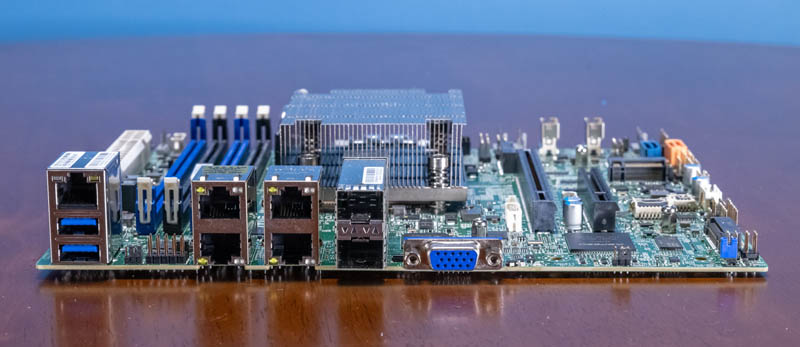
The SFP28 cages are 25GbE ports that are powered by the Intel Xeon D-1700 SoC. We are going to look at them in more depth later in this review.
Next, let us get to management and performance.

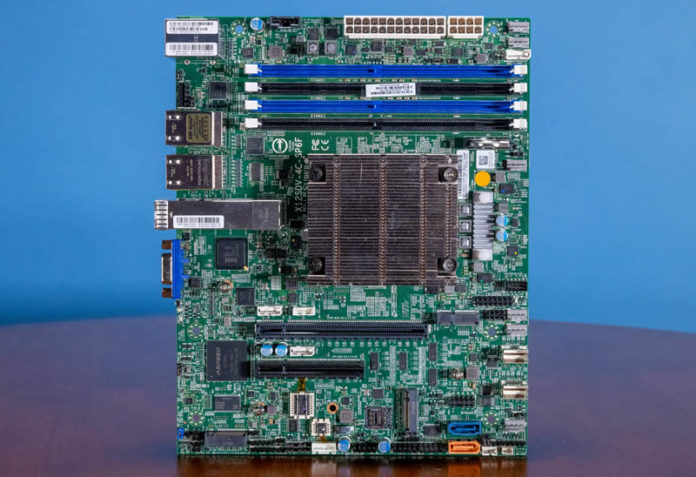



What is the measured performance of the 25gb network port? I am asking because I don’t expect much based on the single lane PCIe Gen 2 connection documented by the lspci output
We run in the 24-25Gbps range on those ports fairly easily. The 25GbE ports are SoC, not PCIe devices like the i210/i350. IIRC the D-1700 series actually has a 100GbE capable network segment so 2x 25GbE is not huge.
Do you have figures for power consumption?
Of course, it is expected to draw more than a D-1518 but is it as bad at idle as the D-2100 series?
“The two 25GbE ports are showing as the OpenFabrics RDMA devices.” Shouldn’t this be: “The two 25GbE ports are showing as Ethernet and OpenFabrics RDMA devices.” ?
it would be interesting if the active-cooler/heatsink of the Xeon-D 2100 fits (SNK-C0111AP4L), in this case the cooling Problem will be solved.
I’d like to notice one thing, although there are 2 SlimSAS ports for U.2/U.3 nvme drives, Supermicro does not offer any cabling for powering those drives and they are not officially supported. There is a JPH1 header for powering disks, but Supermicro said it allows max 2 Sata SSDs. Since U.3 drives are more power hungry, I’d say even if you do manage some combination with cabling, you are limited with providing power through that pins header.
Patrick, I would be very grateful if you could shed some light on this situation, since you have a direct communication with Supermicro representatives.
I’m hoping for an mini-itx version to replace my X10SDV board.
https://www.supermicro.com/en/products/motherboard/x12sdv-4c-spt4f
This is the Mini-ITX version.
Do somebody know if this mobo supports PCIe bifurcation? I haven’t found it in their webpage.
@frankovics.andras: They’ve spelled it wrong, in manual it says :
“Use this feature to configure the bifuraction setting for the PCIe port. The options are
Auto and x4x4x8”
I love the Supermicro SYS-5028D-TN4T which is the XEON D-1541 on a Supermicro X10SDV-TLN4F mobo in a mini-tower with hotswappable 3.5″ trays and provision for 2 more 2.5″ internal disks and the mobo has onboard 2x10Gbe RJ45 and 2x1Gbe.
those originally shipped with a 250W bronze PSU but later were shipped with a 350W GOLD PSU (thats the one I purchased).
In my eyes those X10 gen supermicro mini tower bundles competed directly with the HP ProLiant Microserver Gen10 and the SM blew the HP away in price comparison, performance and features.
I love the newer version reviewed here too, but it is no longer as affordable like the Supermicro X10 with Intel XEON D 1500 series was, and it doesn’t have active cooling or a minitower chassis option (yet), although the newer has far better specs. It’s still probably less expensive than the HP Micro Server though :D
Another important topic regarding Supermicro motherboard purchases. If you go to their e-store they no longer allow for barebone or motherboard purchases by themselves.
In other words, you can’t just purchase this motherboard from Supermicro. You’d have to purchase it inside of a chassis. And that’s not all. You have to purchase it with at least one stick of RAM, at least one disk, and bundled keyboard and mouse.
If you go to a retailer such as Wired Zone, which drop ships from Supermicro, it’s the same problem. They’ll display it as a motherboard for about $890 USD (currently as of me writing this) which you can purchase. But wiredzone will contact you after ordering it to let you know it’s on hold unless you bundle it with memory, disk and keyboard with mouse.
It’s crazy. The only way you can obtain just the motherboard standalone is if purchasing it from a seller that doesn’t drop ship it from Supermicro.
It’s a little bit crazy.
@frankovics.andras thanks, but unfortunately it have limited storage options. I would have liked to see one or two sata port which would bring the total up to 6.
And they are unhealthy expensive here in Europe.
@Casper: if you can even find them.
We are in the same boat. I would like to find a new, decent NAS mobo.
Im surprised patrick did not post any power draw numbers (even just a single value of what it pulls at idle is helpful).
great review still!! (best you will find anywhere) thanks!!
@Benny_RT2 that is unbelievable!! and makes sense as to why the only place you can find the motherboard ALONE is on ebay, and at a higher than MSRP price. Very unfortunate that supermicro has been moving in this direction over the past few years (ie trying to extract $ out of every angle)
I would love to see a review of the Mini-ITX version of this board as it has Dual 10GBase-T LAN instead of the 4Gb ports thus a lot more potential use cases.
https://www.supermicro.com/en/products/motherboard/x12sdv-4c-spt4f
@ m4dm4n
> There is a JPH1 header for powering disks
This header (which is molex male) is found on many supermicro motherboards with soldered CPU (e.g. c2750 boards, X10SDV series, X11SBA-LN4F) to provide power to disks but I can’t find a cable anywhere. It would need to be molex female to SATA female but such a cable just doesn’t seem to exist. Does anyone know whether Supermicro carries a cable? I haven’t been able to find any reference to a cable in any manuals of any of the many Supermicro boards that have a male molex header on the motherboard.
> it would be interesting if the active-cooler/heatsink of the Xeon-D 2100 fits (SNK-C0111AP4L), in this case the cooling Problem will be solved.
I purchased a SNK-C0111AP4L from Wired Zone to test this out. The screw holes align perfectly, but the chokes next to the barcode sticker block the cooler from being screwed in. I ended up using a dremel to remove the ~.25″ x 1″ section of the heatsink that overlaps with the chokes. It wasn’t super straightforward, but the cooler fits like a glove now, with my CPU running 20C cooler than stock.
I’ve connected the CPU fan to FAN1 per the manual, though the fan is fairly loud. I’ll likely replace it with a Noctua 40mm. The SNK-P0070APS4 also looks interesting, and the base appears to be low profile enough to not require modification, but I’m not certain it uses the same screw hole pattern.